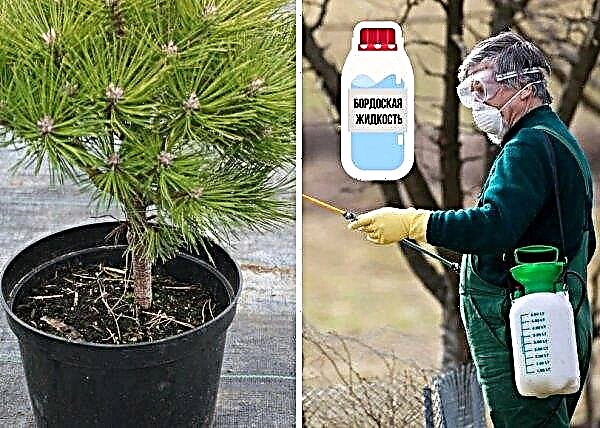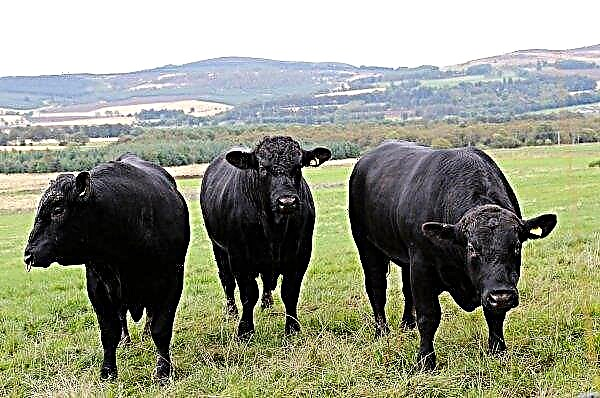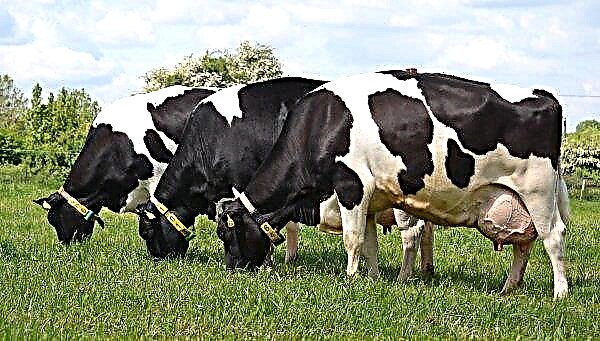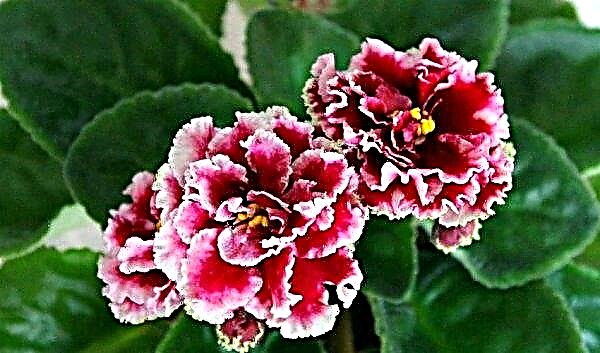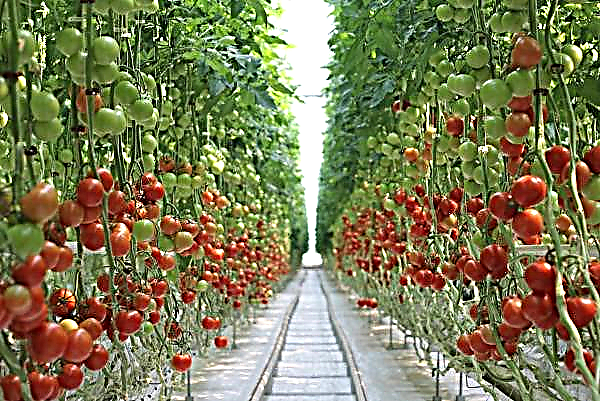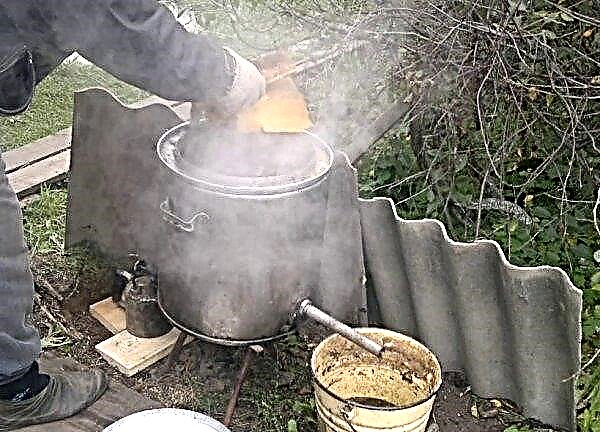The Magic Moonlight is considered one of the most spectacular and luxurious panicle hydrangea varieties, which preserves the intensity of the color of the flowers and a high aesthetic appearance until the onset of frost. What else are the positive qualities of a culture, how to plant and propagate it at home, learn from the article.
Grade description
Panicle hydrangea The Magic Moonlight (hydrangea paniculata Magical Moonlight) is a fast-growing shrub with a height of about 2 m or a small tree up to 3 m, with strong, unyielding vertically growing shoots and a wide, dense half-meter spherical crown. On the branches of the plant are hard, ovoid, slightly elongated dark green leaves with a rough surface and clearly defined venation.
During flowering, which falls from July to October, large inflorescences 20–40 cm long are formed on the shrub, which at the beginning of growth have a rounded shape, and later become oblong, conical.
Their brushes are voluminous, composed of numerous flowers tightly pressed against each other. The color varies depending on the time of growth: at the initial stage they have a beautiful lemon-green hue, closer to autumn they acquire a rich white color. Inflorescences are formed on the young shoots of this year.
Video: Hydrangea Magic Moonlight
Winter hardiness
One of the main advantages of the culture of the described variety is its excellent resistance to frost. It tolerates a decrease in temperature indicators up to -29 ° C. An adult shrub is able to winter without special shelter. Young seedlings need traditional warming: mulching the trunk circle and sheltering the branches with burlap.
Important! The Magic Moonlight is the only panicle hydrangea whose flower color does not acquire a pink or dirty pink hue in the fall.
How to plant
The successful development of hydrangea and the quality of its future flowering will largely depend on the choice of seedling and the correct implementation of planting. For flower growing, experts recommend purchasing material in specialized markets or nurseries. The best option will be plants of three years old. Younger seedlings take root longer and bloom much later. 
When planting shrubs in the southern regions, a semi-shady place should be chosen, in the northern or central ones - a well-lit, sunny area. Young seedlings must be protected from direct exposure to sunlight. Hydrangeas do not tolerate cold winds and drafts. This fact is important to consider when choosing a place to land.
As for the soil, the plant prefers moist, enriched with nutrients, drained acidic soils, with a level of ph = 5.5. The best option for the culture will be loamy soil with a high degree of acidity. Too alkaline soils can provoke the development of chlorosis. To increase acidity, ammonium sulfate and a solution of iron sulfate are introduced into the soil.Important! You can not use calcareous or sandy soils for hydrangea planting.

The most suitable period for planting is considered:
- spring, early April - for the southern regions;
- Autumn, September - for the central and northern zones.
Immediately before laying the seedling in open ground, the site should be dug up, enriched with a mixture of: 60 g of potassium, 100 g of superphosphate and 10 g of humus per 1 m².
The landing technology is traditional and boils down to the following steps:
- dig a recess measuring 30 × 30 × 30 cm;
- cover the bottom of the pit with a layer of drainage from rubble, pebbles or broken brick;
- add fertile soil on top of the drainage tier, which includes a third of a bucket of peat and humus mixed with garden soil;
- Deepen the seedling into the pit, gently fill it with soil, leaving the root neck on the surface;
- tamp the earth around the seedling so that air voids do not form, pour it with settled and not cold water;
- Mulch the trunk circle with a layer of dry leaves or sawdust.
 When planting several bushes between them, an interval of at least 1 m should be maintained.
When planting several bushes between them, an interval of at least 1 m should be maintained.
Flower care
Timely and competent care for Hydrangea Magic Moonlight immediately after planting in open ground is the key to the successful development of the bush in the future. Young plants need high-quality hydration, systematic nutrition and protection for the winter.
Watering
Hydrangea is a moisture-loving culture, therefore, for its quick and complete rooting, it requires systematic irrigation, which is carried out based on the state of the soil - it should always be slightly moist. About 30 liters of water are poured onto one shrub. Culture negatively refers to prolonged drought, which adversely affects the decorativeness of flowers and the intensity of their color.
During hot weather, irrigation activities should be carried out at least once a week. Under normal climate conditions, it is enough to moisten the bushes once a month.In order to preserve moisture in the soil and create comfortable conditions for the growth of the root system, gardeners recommend loosening the soil after each irrigation with further mulching the trunk circle with peat or sawdust.
Fertilizer
Magic Moonlight responds well to dressing. In the spring, at the beginning of the growth of the shrub, it is recommended to nourish it with nitrogen-containing mineral fertilizers that stimulate the growth of green mass. The second time the plant is fed in the budding phase, using phosphorus-potassium preparations per 1 m²: 60 g of superphosphate and 40 g of potassium sulfate.
After the second recharge, the shrub is fertilized two more times: in the middle of summer and in the beginning of autumn, using complex minerals as top dressings.
Pruning
In order for panicle hydrangea to maintain its high decorativeness, it must be systematically susceptible to pruning. Such a procedure stimulates the flowering of a culture, helps to increase the number of inflorescences, and serves as an effective prevention of various fungal ailments. In early spring, it is advisable to carry out sanitary cutting, during which old, dry, too weak, infected or broken branches should be removed.
Forming haircuts are recommended in two stages:
- in the autumn, the bush is exempted from all inflorescences, weak or diseased shoots;
- in spring, before the sap flow begins, the culture is thinned out by cutting the branches growing deep into the bush, sticking out, broken branches after the winter. Annual branches shorten up to 3-5 pairs of buds.
Did you know? Hydrangea first came to the countries of Europe at the beginning of the 19th century from Japan. In those days, only two types of culture were known: white and red.
Winter preparations
When growing hydrangeas in the warm southern regions, there is no need to cover the flower with a special method for the winter. If the plant is cultivated in cooler climatic zones, then it is recommended to pay attention to its warming.
Preparing for the winter takes place in several stages:
- in autumn, the bush is abundantly watered, the trunk circle is mulched with natural materials;
- a few weeks before the alleged frosts, the culture is wrapped in burlap or any other "breathing" cloth;
- at a height of about 30 cm, a protective frame of mesh is built over the shrub;
- the space between the insulation and the grid is filled with dry leaves;
- the whole structure is covered with a dense film. Such a shelter will protect hydrangea from frost, ice and breaks.
 1- tilted shoots, 2 -cocking, 3- spruce branches, 4- lutrasil, 5- stone
1- tilted shoots, 2 -cocking, 3- spruce branches, 4- lutrasil, 5- stoneBreeding methods
There are several methods of breeding hydrangea at home, a description of the most common is presented below.
Did you know? Hydrangea is an amazing flower that has the unique ability to accumulate aluminum and iron. Thanks to this quality, the plant is endowed with a very beautiful blue and blue color.
One of the simplest and most affordable methods of culture breeding is reproduction by layering, which is carried out as follows:
- in the spring, a ditch about 15 cm deep is dug next to the mother bush;
- on the shrubbery, choose one of the strong and strong branches, clear of the wood layer;
- the selected shoot is bent to the soil, lowered into the recess, fixed with a special wire pin, sprinkled with soil;
- after the formation of shoots on the lay, it is carefully cut from the mother plant;
- when a new seedling grows stronger and well rooted, it is allowed to plant it in another place.

Hydrangea cultivation by cuttings is considered the most productive and most used method. The technology of its implementation is quite simple:
- the branches that remained after trimming the bush are placed in the water for several days;
- cut the cuttings so that everyone gets 3-4 kidneys. Places of the lower cut are treated with any root stimulant;
- prepare the substrate from garden soil, peat and sand. To increase soil moisture, a little sphagnum is added to it;
- the shank is buried in the prepared soil mixture, the container is covered with plastic wrap and placed for three weeks in a dark place;
- when rooting the cuttings, the film is removed, and seedlings are provided with regular watering.

Planting material in open ground is allowed only in August. Prior to this period, the root system is fully formed, gets stronger and will be able to adapt well to new growing conditions.
Some gardeners practice hydrangea propagation by dividing the bush. To carry out the procedure:
- after the end of the flowering phase, dig out the bush, carefully divide it into parts so that a few buds remain on each;
- shorten the root processes, remove dry, infected, too weak;
- Plant the received seedlings in a prepared place.

Diseases and Pests
Hydrangea of the described variety is characterized by strong immunity, high resistance to ailments and pests. However, with poor care and adverse climate conditions, it can be “attacked” by such parasites:
- spider mite. It feeds on the juice of the flower, as a result of which the leaves begin to turn yellow, dry out and fall off;
- aphids. The zone of greatest insect parasitization is the stem, from which the pest sucks the juice.
 High efficiency in the fight against parasites is provided by modern insecticidal solutions: Thiophos, Aktara, Karbofos.
High efficiency in the fight against parasites is provided by modern insecticidal solutions: Thiophos, Aktara, Karbofos.
Of the diseases, the plant most often affects:
- Powdery Mildew The fungus affects almost all parts of the culture, yellow spots form on the leaves, which in the process of developing the ailment increase and fill the entire leaf plate. It is possible to cure the bush by spraying it with a solution of copper sulfate.
- Chlorosis. With the defeat of this disease, the green mass loses its bright color. Chlorosis can be eliminated by treating the plant with potassium nitrate preparations.
 Regular spraying of bushes with insecticides and fungicides is considered to be excellent disease prevention and pest protection.
Regular spraying of bushes with insecticides and fungicides is considered to be excellent disease prevention and pest protection.Is it possible to change the color of inflorescences
The natural color of hydrangeas of the Moonlight variety varies from lemon-green at the beginning of flowering to snow-white in the middle of the flowering phase. However, experienced gardeners know some simple methods to change the color of inflorescences.
To make the color of the flowers of the plant different, it is recommended to add:
- special dyes - allow you to get any desired color, depending on the shade of the paint;
- crystals of aluminum or iron - make it possible to make flowers of blue color;
- Manganese or peat - able to color the inflorescences in pink.
If the gardener wants to get different shades of flowers within one shrub, then the root processes should be divided by a partition, after which one side of the plant should be watered with water of one color, and the other - of the other.
Panicled Hydrangea Magical Moonlight deserves special attention because it impresses gardeners with its chic lush flowering and the ability to maintain a highly decorative appearance right up to frosts. The variety tolerates winter cold, has strong immunity and requires traditional agricultural practices to maintain good functioning.

